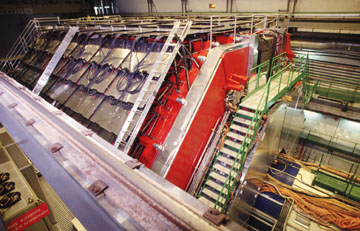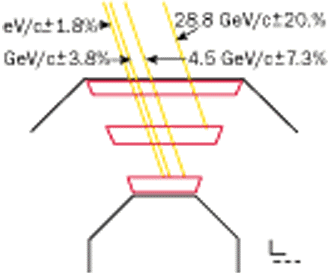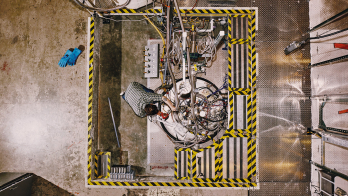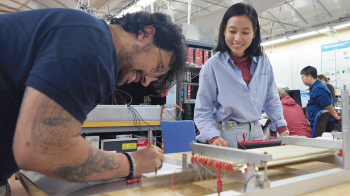Also under way at CERN is the L3 experiment at LEP, which has installed a 200 sq. m screen of scintillator to intercept comic rays arriving from the atmosphere.

L3+C, an offshoot of the L3 experiment at CERN’s LEP electronpositron collider, has been a “recognized” experiment at CERN since April 1998. It takes advantage of the unique properties of the big L3 muon spectrometer (low energy threshold compared to other underground detectors and unrivalled momentum resolution over a wide momentum range) for accurate measurements of cosmic-ray muons penetrating 30 m underground.
A new muon trigger, readout and data acquisition system have been installed, as well as a 204 sq. m scintillator matrix covering the L3 magnet to time the passage of particles. Data are collected independently, in parallel with L3 running at LEP.
New results for a variety of fundamental topics in cosmic rays, astrophysics and particle physics are expected. The cosmic-ray muon momentum spectrum, zenith angular dependence and charge ratio are being measured to 1% between 10 and 2000 GeV, thanks to L3’s muon drift chambers and large magnetic volume.
The results will provide new information on the primary composition of cosmic rays, shower development in the atmosphere, and pion and kaon levels at high energies. These data will also help us to understand the “atmospheric neutrino puzzle”, where an anomalous muon neutrino signal seen by underground neutrino detectors is heralded as an indication of neutrino oscillations. In particular, the precision measurements will allow a prediction of the absolute number of upward-moving, through-going muons above 10 GeV observed by Super-Kamiokande and MACRO underground.
L3+C started gathering data in 1998. Then in early 1999 it increased its acceptance considerably, achieving an event rate of 550 Hz. In addition to providing more reliable data, this extends both the momentum measurement and the angular range.

The detector could reveal bursts of point source signals, and eventually gamma-ray bursts, and analyse their associated muons. The absence of high energy, upward-moving muons (above a few hundred giga electron-volts) will allow a limit to be set on the neutrino flux from active galactic nuclei. Studies of the primary composition of cosmic rays in the “knee” region (near 1015 eV) will be boosted in a unique way by recording muon “families” and measuring all of their momenta. With exotic events recorded by many different experiments, particle momentum spectra should reveal clues to the processes involved.
The detector will also intercept some upward muons (due to particles that have traversed the Earth). Time variations could reveal meteorological or sidereal effects. Correlations with events seen by other detectors are also among L3+C’s experimental objectives.
Observing the Moon’s muon shadow may give a flux limit of primary antiprotons near 1 TeV the Earth’s magnetic field acting as a convenient momentum analyser and the Moon as an absorber of cosmic particles.
Independent apparatus
The collaboration is preparing to install 50 scintillators below the roof of the L3 access hall (above ground). This air shower array will help to estimate the primary energy of some showers associated with the muons measured underneath. This apparatus is completely independent and runs by itself. Events are correlated via the GPS satellite clock and a signal in the data acquisition system.
The L3+C experiment already has collected some 900 million events and is expected to run up to the end of the LEP operation period next year. The first data were presented at August’s International Cosmic-Ray Conference in Salt Lake City.








